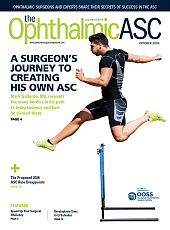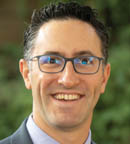“Peer Perspectives,” a new series from Retinal Physician, affords readers the opportunity to go behind the scenes and learn from editorially independent one-on-one conversations between expert retina specialists.
In this inaugural series of conversations, Sophie J. Bakri, MD, and Roger A. Goldberg, MD, present advances in the care of patients with macular telangiectasia type 2 (MacTel). Their three-part conversation provides an introduction to the disease and covers topics including diagnosis, treatment, patient management, and more. In this third conversation, Dr. Bakri and Dr. Goldberg discuss patient selection for treatment and continuing patient management issues, both short and long term.
Patient Selection for Treatment
Sophie J. Bakri, MD: To continue our conversation on macular telangiectasia type 2 (MacTel), let’s discuss a key topic: patient selection for the FDA-approved treatment (Encelto; revakinagene taroretcel-lwey; Neurotech Pharmaceuticals). Roger, who are the patients likely to have the most positive outcome with this implant, which slows the progression of MacTel?
Roger A. Goldberg, MD: As we discussed in our previous conversation, we can detect MacTel at its early stages, long before patients have any symptoms. In the Phase 3 clinical trials, patients were required to have some degree of photoreceptor loss, as evidenced by a break in the ellipsoid zone. In post-hoc analyses, the data suggest that patients who responded most favorably to the Encelto implant tended to be younger, with smaller lesions and less ellipsoid zone loss. These findings underscore the potential value of early intervention. That said, I am looking for 2 or 3 things to be present to consider treatment.
First, I'd like there to be some degree of photoreceptor loss evident; second, I would like there to be some patient-reported symptoms before treatment is considered. The third piece isn’t a requirement, as sometimes we first see and diagnose patients once the disease is already quite advanced, but it’s nice for the patients we have been following in our clinics for a while to see evidence of disease progression as well. To me, disease progression can be anatomic (e.g., worsening photoreceptor loss) or functional, with worsening symptoms.
Of note, the clinical trial program excluded patients with retinal pigment epithelial (RPE) migration into the retina. The hyperreflective RPE material disrupts the OCT signal, so in that area, you can’t measure photoreceptor or ellipsoid zone loss, which were key measurements for the study. However, because temporal juxtafoveal pigment migration is a common feature in MacTel, I would certainly not consider this finding to be exclusionary for patients who want and need treatment.
Dr. Bakri: I agree that younger patients and those with smaller lesions are the preferred patients for treatment. But that doesn’t mean the treatment can’t help other patients who have MacTel, as the implant may help preserve retinal structure, stabilize the condition, and slow further decline.
We have found that patients with smaller lesions may struggle with the decision for treatment because they haven’t suffered vision loss yet. For these patients, a discussion about the anatomy of the eye, especially the retina and fovea can be a useful tool for education and early intervention.
Also, many patients find it counterintuitive to request surgery for the better eye, as was done in the clinical trial—they want surgery for the eye with poorer vision. But because the goal of the treatment is to preserve vision by protecting the photoreceptors, the therapy is most effective in eyes where photoreceptors are still viable, which is typically the eye with better vision.
Dr. Goldberg: I agree. Often patients are fixated on treatment to stabilize vision in the worst eye first. And because MacTel is a bilateral disease, I might consider treating the worse seeing eye first and then, whether it’s a month or a few months later, treat the second eye.
While MacTel is bilateral, it is often asymmetric, and one eye can be significantly advanced while the fellow eye isn’t even showing evidence of photoreceptor loss. As I discussed earlier, I like there to be some evidence of photoreceptor loss present before I would consider implanting Encelto, whether for the first or second eye. When I say “photoreceptor loss,” I am referring to the break in the ellipsoid zone, which was the primary anatomic outcome in the clinical trials. That said, where there is EZ loss, there are no photoreceptors, and I find when I talk to patients about lost photoreceptors, they are much more engaged in the discussion. If you mention EZ loss to a patient, I can pretty much guarantee you’re talking over their head!
Postoperative Evaluation
Dr. Bakri: Roger, in your private practice, after the patient receives the implant, what are the next steps in terms of follow-up care?
Dr. Goldberg: Although we don't do a pars plana vitrectomy in eyes that receive the implant, I do treat the procedure like a typical surgery where I'll see the patient a day, a week, and a month after surgery.
I prescribe an antibiotic and a steroid eye drop topically for the first week and then taper off the steroid in subsequent weeks. Eventually, I get the patients back to the same cadence of follow-up as before they had the implant, which is follow-up about every 6 months for MacTel patients.
In tracking the progression of the disease, I noticed that some of my patients treated 5 years ago in the initial phase 3 clinical studies have a marked difference in the progression of the disease between the treated eye and untreated fellow eye in terms of photoreceptor loss and, occasionally, patient symptoms.
In addition, I always examine the sclerotomy site at subsequent visits to ensure there's no conjunctival erosion over the sutures or any extrusion of the implant. While I haven't seen these in my patients, the adverse events in the clinical program most commonly occur around the suture tails or the sclerotomy site, which can lead to conjunctival erosion. It’s critical to address erosion—specifically, to close the defect—and ensure that Tenon’s capsule is mobilized and provides adequate coverage over the site. My preferred approach is to bury the suture tails by taking an appropriate scleral bite and trimming the suture tail right where it exits the sclera so that no tail remains exposed.
Sophie, because we practice in different settings—I'm in private practice, and you're in an academic setting—when it comes to managing MacTel, whether before or after treatment, how do you typically coordinate care with the referring ophthalmologist or optometrist? I imagine in Rochester, Minnesota, many of your patients travel long distances to see you. What does your usual follow-up cadence look like?
Dr. Bakri: You're right—since MacTel is a rare disease, many patients do travel long distances to access specialized care, whether it's for clinical trials or surgical implantation of devices like Encelto. I try to be very mindful of that and do my best to partner with their referring provider, typically an ophthalmologist or retina specialist. If the referring provider is less familiar with MacTel or with the treatment specifically, I’ll often send detailed written instructions to help guide ongoing management locally. For example, as you mentioned, I will ask them to look for conjunctival erosion. Or, if the patient has low vision, I will ask the referring provider to make a low vision referral because these resources are available on a state-by-state basis.
It’s also important to recognize that many patients prefer to be followed locally. While that’s feasible, it’s critical to ensure continuity of care, especially because complications can occur independent of the implant itself. For instance, choroidal neovascularization is a known potential complication of MacTel, with or without the implant.
Therefore, I recommend regular follow-up with the managing ophthalmologist who will be able not only to perform periodic optical coherence tomography (OCT) imaging but also to reinforce home monitoring with tools such as the Amsler grid. This dual approach helps facilitate early detection of changes that may require timely intervention.
Patient Management: Engaging the Patient
Dr. Bakri: One of the common questions patients ask is, “what more can I do?” Many want to take personal responsibility for managing their condition and are particularly interested in things such as diet. How do you typically respond when a patient asks what more they can do to help manage their MacTel?
Dr. Goldberg: Interestingly, we don’t currently have a specific supplement or dietary intervention that has been definitively shown to slow the progression of MacTel, particularly in terms of photoreceptor loss.
Dr. Bakri: Yes, and many patients with MacTel also have type 2 diabetes, hypertension, or other systemic conditions. So, there are often opportunities to provide guidance that extends beyond MacTel itself.
Dr. Goldberg: Exactly. Some of the foundational work from the Lowy Medical Research Institute—including studies published in The New England Journal of Medicine—has shown that a significant proportion of patients with MacTel also have type 2 diabetes. As a result, I often address broader systemic health concerns important for a diabetic, including maintaining good glycemic control. This may not benefit their MacTel, but perhaps I can help their overall health and well-being!
I remind patients that, in addition to monitoring for MacTel progression, we must also stay vigilant for signs of diabetic retinopathy. I emphasize the importance of maintaining good control of their blood sugar and blood pressure—the same advice I offer to my diabetic patients without MacTel. Optimizing overall systemic health remains a critical part of patient management.
Dr. Bakri: I agree. We take a similar approach and often include conversations about overall health. When it comes to vision specifically, it’s important to remember that vision loss isn’t always all-or-nothing. Low vision is traditionally defined as 20/200 or worse, but many patients experience a stage in between where they still face real challenges. At that point, we’ll often ask the referring provider to connect the patient with a low vision specialist.
What do you advise patients at this point?
Dr. Goldberg: MacTel is definitely a disease where the visual impact and the measured visual acuity aren't always aligned well with each other because many patients can read letters on a Snellen chart one at a time and be 20/20 or 20/25, despite having significant symptoms. For example, I often hear patients have difficulty trying to read the news ticker that appears at the bottom of the television screen. That crawl of text is not stationary, so it moves in and out of the patient’s blind spots and can be quite problematic. In these instances, I try to work closely with the patients’ optometrists or low vision clinics.
However, I certainly don’t pretend to be a low vision specialist. The key for us, as retinal specialists, is to be open-minded and aware that these patients might still be suffering even if they have measured good vision. We can encourage them to work with their optometrist to help explore what tools might help patients maintain their independence.
Dr. Bakri: I agree. We need to take an open-minded approach that considers not only the disease but also the patient. When we treat the progression of the disease, along with addressing the functional and emotional challenges associated with it, we can ultimately help enhance the quality of life for our patients with MacTel.










